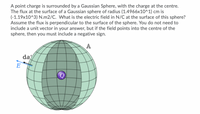Question

Transcribed Image Text:A point charge is surrounded by a Gaussian Sphere, with the charge at the centre.
The flux at the surface of a Gaussian sphere of radius (1.4966x10^1) cm is
(-1.19x10^3) N.m2/C. What is the electric field in N/C at the surface of this sphere?
Assume the flux is perpendicular to the surface of the sphere. You do not need to
include a unit vector in your answer, but if the field points into the centre of the
sphere, then you must include a negative sign.
A
da
E
Expert Solution
This question has been solved!
Explore an expertly crafted, step-by-step solution for a thorough understanding of key concepts.
Step by stepSolved in 2 steps

Knowledge Booster
Similar questions
- A uniformly charged disk of radius R=25 cm carries a total charge of Q=2 μC. R P 1 Find the magnitude of the electric field E created by the disk at the point P located at distance 40 cm from the center of the disk. E = [N/C] 2. What is the direction of the electric field E created by the disk at point P. Direction: 3. Write the expression of the electric filed E created by the disk at point P. Ē =< [N/C] 4. Find the magnitude of the electric field E created by the disk at the point P located at distance 8 m from thearrow_forwardA sphere shell of radius R, centered on the origin, has a uniform surface charge density /sigma and no charge in its interior. What is the magnitude of the electric field outside the sphere, at the distance r from the center, where r > R?arrow_forwardThe electric field everywhere on the surface of a thin, spherical shell of radius 0.700 m is of magnitude 855 N/C and points radially toward the center of the sphere. (a) What is the net charge within the sphere's surface? 4.655e(-8 x nC (b) What is the distribution of the charge inside the spherical shell? O The positive charge has a spherically symmetric charge distribution. O The negative charge has a spherically symmetric charge distribution. O The negative charge has an asymmetric charge distribution. O The positive charge has an asymmetric charge distribution.arrow_forward
- The Electric Field of a Charged Cylinder and a Concentric Cylindrical Shell. A non-conducting cylinder of radius a is charged with charge density p(r) = p.r, where r is the distance from the cylinder axis. The cylinder is placed inside a shell with cylindrical inner and outer radii b and c, respectively. The outer shell is charged with a uniform charge density p(r) = Po. The cylinder and the shell are concentric (see figure). D B b 0 Derive the formulas for the magnitude of the electric field at points A, B, C, and D. Guidance: 1. If required by the formulas, specify Coulomb's force constant through the Vacuum Permittivity, E = 1/4nk instead of Coulomb's onstant, k. 2. Type epso, rhoo, and pi, if the respective symbols Eo,Po, and n, are required.arrow_forwardCalculate the absolute value of the electric flux for the following situations (In all case provide your answer in N m2/C): a. A constant electric field of magnitude 300 N/C at a 30 degrees angle with respect to the flat rectangular surface shown in the Figure above. b. A uniform electric field E = (70 i + 90 k) N/C through a 4 cm ×5 cm in the x-y plane. c. A uniform electric field E = (−350 i + 350 j + 350 k) N/C through a disk of radius 3 cm in the x-z plane.arrow_forwardA hollow sphere of radius .05m contains a negative charge sitting right at its center. (The sphere itself is not charged.) The electric field everywhere on the surface of the sphere has the magnitude 3.0*10^-4 N/C. Draw the sphere and show the electric field vectors on your drawing. What is the total electric flux through the surface of the sphere?arrow_forward
- A point charge is located at the origin. Centered along the x axis is a cylindrical closed surface of radius 10 cm with one end surface located at x = 2 m and the other end surface located at x = 2.5 m. If the magnitude of the electric flux through the surface at x = 2 m is 4 N . m2 /C, what is the magnitude of the electric flux through the surface at x = 2.5 m? Select one: a. 1.8 N . m2 /C b. 2.56 N . m2 /C c. 1.0 N . m2 /C d. 4.0 N . m2 /C e. 5.0 N . m2 /Carrow_forwardA cylinder has a volume of 5.2 cm^3 and a charge density of 6.1 μC/cm^3, and is enclosed in a spherical surface with a radius of 17.5 cm. What is the total charge on the cylinder? What is the total electric flux through the surface of the sphere?arrow_forwardA uniformly charged conducting sphere of 1.2 m diameter has a surface charge density of 8.1 µC/m2.(a) What is the net charge on the sphere?(b) What is the total electric flux leaving the surface of the sphere? Show step-by-step calculation. Please Don,t copy.arrow_forward
arrow_back_ios
arrow_forward_ios